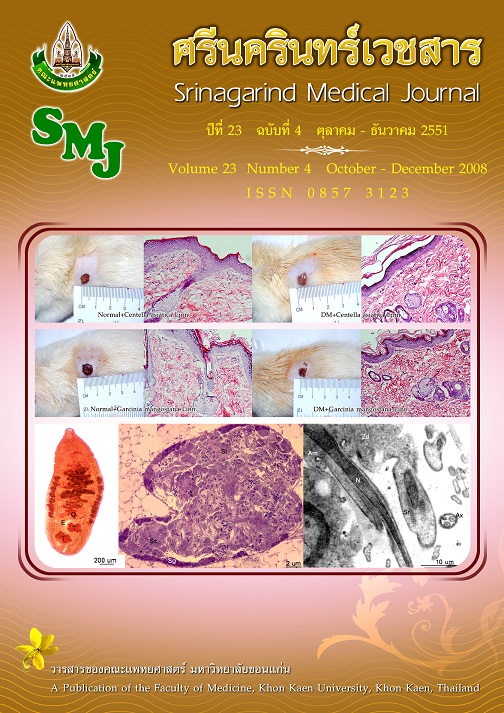Factors Associated with Failure to Receive Secondary Prophylaxis of Rheumatic Fever Patients in Srinagarind Hospital, Khon Kaen University
บทคัดย่อ
Background: Acute rheumatic fever is a severe disease. The patient who had recurrent rheumatic fever that had permanent cardiac pathology and might be dead. Secondary prophylaxis with benzathine penicillin 1.2 million unit every four weeks was very important for all patients. Objective: To identify factors associated with failure to receive secondary prophylaxis of rheumatic fever patients in Srinagarind Hospital, Khon Kaen University. Study design : A case-control study. Setting: Srinagarind Hospital, Khon Kaen University Subjects and methods :This study was conducted from February 2003 to August 2004 with 204 rheumatic fever patients in Srinagarind Hospital, Khon Kaen University. We interviewed the patients who regularly received secondary prophylaxis (control). We sent questionnaires to the patients who did not regularly receive and never received secondary prophylaxis by mail (case). Forty-one questionnaires were sent back (57 %). Results: There were 163 patients (79.9%) in control group with mean age 14.18 + 3.7 years, 98 patients were male (48.0%) and 65 patients were female (31.9%). There were 41 patients (20.1%) in case group with mean age 24.5 + 5.2 years, 16 patients were male (7.8%) and 25 patients were female (12.3%). We analysed factors associated with failure to receive secondary prophylaxis by bivariable analysis and multiple logistic regression (forward stepwise). We found that convenience of traveling, convenience of appointment and general health status of the patients statistic significantly associated with failure to receive secondary prophylaxis (p < 0.05).The patients who were inconvenient to travel had 8.2 times of failure to receive secondary prophylaxis compared with the patients who were convenient (adjusted Odds Ratio = 8.2, 95% CI = 2.7-24.2). The patients who were not convenient for appointment had 20 times of failure to receive secondary prophylaxis compared with the patients who were convenient (adjusted Odds Ratio = 20, 95% CI = 5.5-72.9). The patients who had poor general health status had 15 times of failure to receive secondary prophylaxis compared with the patients who had good general health status . (adjusted Odds Ratio = 15, 95% CI = 2.3-99.9) Conclusion: Factors associated with failure to receive secondary prophylaxis of rheumatic fever patients in Srinagarind Hospital Khon Kaen University were the convenience of traveling, convenience of appointment and general health status of the patients.*This study was supported by Khon Kaen University.
Keywords: Rheumatic fever , Secondary prophylaxis , Failure to receive prophylaxis.
ดาวน์โหลด
รูปแบบการอ้างอิง
1.
Weraarchakul W, Panamonta M, Weraarchakul W, Chaikitpinyo A. Factors Associated with Failure to Receive Secondary Prophylaxis of Rheumatic Fever Patients in Srinagarind Hospital, Khon Kaen University. SRIMEDJ [อินเทอร์เน็ต]. 4 พฤศจิกายน 2013 [อ้างถึง 22 ธันวาคม 2025];23(4):408-15. available at: https://li01.tci-thaijo.org/index.php/SRIMEDJ/article/view/13106
ฉบับ
ประเภทบทความ
Original Articles




